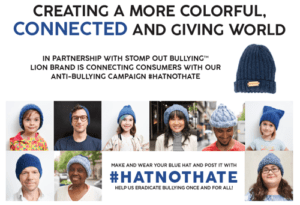Yarn and knitting products retailer and manufacturer Lion Brand Yarn launched in 1878. But a look at Lion Brand’s digital strategy shows it hasn’t slowed down with age—at least not when it comes to using the web to generate buzz, make product decisions and drive sales.
The retailer has been quick to leverage the power of the web to sell directly online and generate more business from the chain retailers, such as Hobby Lobby Stores Inc. and Michaels Stores Inc., that sell its products, says Evan Blumenthal, chief sales officer.
“We launched online back in 1996. I call it ‘BG’ or before Google,” Blumenthal says. “People forget what life was like BG.” Google Inc. launched in 1998. Blumenthal’s cousin designed the family owned company’s first e-commerce site, which was basically an online version of the retailer’s mail-order catalog, he says.
Soon after launching the rudimentary e-retail site, Blumenthal and his colleagues learned that it could use the connectivity of the web to not only sell but to create a community and draw in shoppers by providing knitting patterns and project ideas.
Building traffic and a community
One of Lion Brand’s first strategies was to make knitting patterns—which typically are sold for between $1 and $5—free and downloadable via its e-commerce site. While offering free patterns has become somewhat more common in recent years, in the late 1990s, it was rare for a merchant to give them away, Blumenthal says.
That hook brought more visitors to Lion Brand that it could communicate directly with. It also informed Lion Brand on what trends and designs were resonating with shoppers based on the patterns they downloaded.
Shoppers would then come back to the site to purchase the yarn they needed to complete a project or seek its brand out in retail stores, Blumenthal says. Giving away patterns for free also helped the retailer build relationships with the chains it sold to by informing them of popular knitting trends, and that data gave stores confidence to purchase more specific types of yarn from Lion Brand. Today, e-commerce accounts for about 10% of total sales at Lion Brand, and LionBrand.com hosts 10,000 pages of content on its website, including an ample selection of knitting patterns.
“[Giving away patterns] helped us not only identify what products people like to make, such as scarves or baby sweaters, but the actual type of pattern,” Blumenthal says. “Then, we communicate those trends to stores based on what we are seeing and say which patterns are really popular.”
Over the past decade, Lion Brand’s community has grown bigger than its website: It’s garnered nearly 600,000 Facebook likes. Its email list has grown to 1.9 million subscribers and open rates for its email newsletter hover around 40%, Blumenthal says.
Engaged shoppers
The high email engagement helps generate buzz and sales for specific products. For example, it promoted a “Mystery Box” of nine balls of yarn for $9.99—a typical price for such an assortment would be $50-$55—and promoted it almost solely via email. To give consumers a bit more confidence in what they were buying, they could select the thickness or weight of the yarn, as many knitters have a preference for certain varieties. However, the color and other attributes weren’t revealed. “We wanted to move some product that wasn’t moving as quickly as we had hoped,” Blumenthal says.
Sales of the boxes exceeded expectations by nearly ten-fold in one week and the boxes are now sold out, according to Lion Brand’s website. What’s more, as consumers learned about the boxes via email, they took to social media and created a special page specific to the mystery boxes. While the page has only been up for about two days, it’s already garnered hundreds of followers, Blumenthal says.
An earlier example of a product that also went viral after email marketing is the brand’s Mandala yarn, which has a unique design that includes many colors fading into one another and is sold in the shape of a circular cake rather than a ball. Fans of the specific yarn have created an active Facebook community that has garnered 45,000 members.
“We didn’t create the page, our customers did, and they are constantly talking about the yarn and sharing their work on it. There’s an amazing dialogue,” Blumenthal says.
Current projects

Lion Brand is launching a campaign for anti-bulling awareness month in October that encourages knitters to create blue hats and post them to social media with the hashtag #HatNotHate
Other recent marketing projects include Colors of the Year, which the retailer launched this year. With the marketing campaign, Lion Brand has selected a color for each month, which it then uses on social media, such as Instagram and Facebook, in brochures, in marketing materials, at trade shows and in its wholesale catalogs. “We are showing we are an authority on color in the yarn world,” Blumenthal says. The campaign also creates a common thread and a united message across the retailer’s many channels, he says.
It’s also launching an anti-bullying campaign later this year, where in collaboration with the organization Stomp Out Bullying it’s encouraging consumers to knit hats during October—anti-bullying awareness month—in the color blue, the cause’s featured color. Knitters are encouraged to share photos of their creations on social media with the hashtag #hatnothate. Blumenthal says it chose to promote knitting hats because they are relatively easy to create—much easier than, for example, a blanket.
It’s also partnered with “Wheel of Fortune” celebrity Vanna White to develop and promote a series of yarn sold by Lion Brand in which a cut of all sales go to St. Jude Children’s Research Hospital. The proceeds from the sale of the yarn to the hospital recently reached $2 million. Other projects in the pipeline include a campaign with crayon company Crayola LLC that will launch in the next six to 12 months.
Favorite